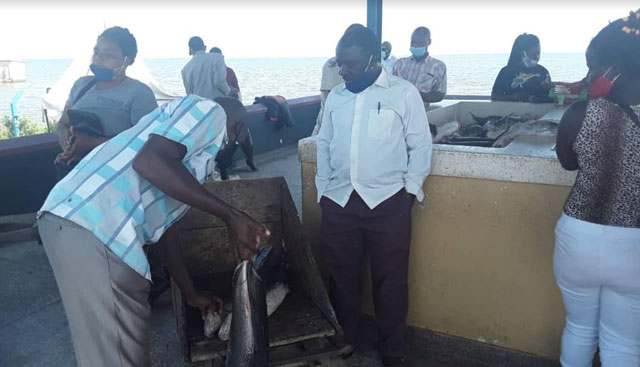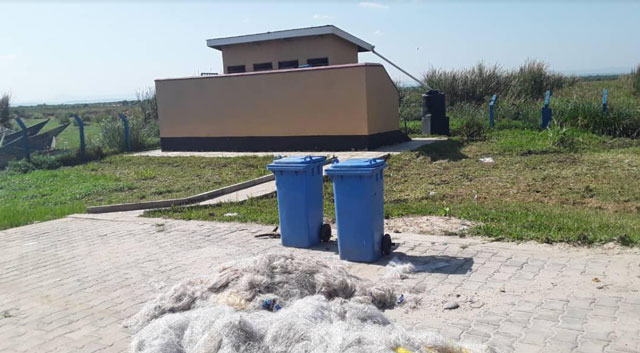
Improved fish productivity
According to Steven Ogwete, an engineer at the Ministry of Water and Environment who is also the national project coordinator of LEAF II, the project which started in 2016, wanted to address major environmental threats to the shared transboundary lake systems on the Uganda-DR Congo border.
“The overall objective is to sustainably increase the lake’s fish productivity by promoting good fish capture and management practice, restoration of the lakes’ catchments and improvement of water quality,” he said.
Ogwete says in 2018, two frame surveys conducted on Lake Albert and Lake Edward found that 32,092.8 tonnes of fish were caught every year on Lake Edward; 29,347.2 tonnes in Congo and 2,745.6 tonnes in Uganda with a combined beach value of about US$ 63,000.
Meanwhile, in Lake Albert, up to 376,617 tonnes were caught with 335,475.6 tonnes caught in Ugandan waters and 41,142 tonnes in Congolese waters. The total catch’s combined beach value was about US$ 279,000.
The survey also found over 200 landing sites (107 in Uganda and 94 in DR Congo) were registered on Lake Albert while Lake Edward had 28 landing sites (23 in DR Congo and five in Uganda). The survey concluded that more money could be earned if deliberate improvements on landing sites were made.
Five fish landings sites constructed in four years
NELSAP-CU, one of two investment arms of the Nile Basin Initiative, decided to build and equip landing sites with integrated facilities; including clean water, washing bays, toilets, cold chains for fish storage and access roads at a cost of about US$ 24 million (Shs 84bn).
Over the last four years, five fish landing sites in Uganda have been constructed complete with 61 modern fish drying facilities under construction while 19 modern fish smoking kilns are under construction.
Besides Rwenshama, other landing sites which have benefitted from the project include; Mbegu in Hoima District, Mahyoro in Kamwenge District and Dei landing site in Pakwach District, in northwestern Uganda.
The project started with only 13 districts in Uganda but is currently in 30 districts within the Lakes Albert, Edward and George Basin including; Buliisa, Bundibugyo, Bunyangabu, Bushenyi, Hoima, Kibale, Kabale, Kabarole, Kagadi, Kakumiro, Kamwenge, Kanungu, Kasese, Kibaale, Kikuube, Kisoro, Kitagwenda, Kyegegwa, Kyenjojo, Masindi, Mitooma, Mubende, Nebbi, Ntoroko, Ntungamo, Pakwach, Rubanda, Rubirizi, Rukiga, Rukungiri and Sheema. In the DR Congo, the project is North Kivu Province (L. Edward) and Ituri Province (L. Albert).
Ogwete told a group of journalists from Burundi, Kenya, Tanzania, Rwanda and Uganda in Fort Portal that before the improvements at Rwenshama were made only 288 tonnes of fish were traded in 2019 but following the commissioning of the landing site, this shot up to 360 tonnes— a 25% increase attributed to the improved facility. Mutabazi also says he started seeing improvements at the landing site in 2019.
Geoffrey Kayongo, the project sociologist told The Independent that before the construction of this landing site, there was a lot of illegal fishing just like all other landing sites in Uganda.
“So we brought on board the national army’s Fish Protection Unit as partners in the project.”
Kayongo said the army has been helping with phasing out the illegal fishermen.
“Every boat at this landing site, for instance, is now registered and marked,” Kayongo told The Independent, “Each boat has the owner’s name, telephone number, the first two letters of the name of the landing site and the first three letters of the name of the district the boats operate from.”
The next phase, according to Stephen Opio, the Environmental Officer for the project, is demarcating the fish breeding sites. He said they have identified the breeding sites and sensitized the community about their importance.
“We have tried to change their mindset by making them understand that protecting the fish breeding sites is the most important thing they can do to their fish business; without the breeding grounds, they are out of business.”
On Lake Edward, there are up to 37 breeding areas spread across an area of up to 11,300 hectares with 18 being in DR Congo spread over an area of 8,690ha while 19 are in Uganda (2,610 ha). Meanwhile, on Lake Albert, there are 29 fish breeding areas (11,515 ha). Ten are in DR Congo (5,725ha) while 19 are in Uganda (5,790ha).

Mutabazi, the fisheries officer, says a committee of fishermen, fish brokers and fish traders have agreed on a sum of money to be paid every day towards management of the Rwenshama landing site beyond the project’s end which is scheduled for mid-next year.
“Our main objective was to improve fish handling at this landing site. So we also wanted to fix the software aspects of the people by teaching them behavioural change; especially sanitation, alternative livelihoods and fight against gender based violence,” adds Kayongo.
Working with DR Congo
But challenges remain, including insecurity in the Congolese part of Lake Edward.
A bilateral fisheries agreement between Uganda and DR Congo was signed on October 20, 2018 and is now operational. There are now bilateral monitoring and surveillance of activities of the lakes and senior government officials say there are now improved and harmonized standard operating procedures for joint lake patrols.
Dr. Joyce Nyeko, the Director of fisheries resources at the Ministry of Agriculture, Animal Industry and Fisheries says the joint operations have for instance caused the arrest and exchange of 237 illegal fishers from the two lakes.
About 900 monofilaments, 15,465 illegal hooks, 1,165 gill nets and 237 beach seines have been destroyed. Also destroyed were 1,697 silver fish undersize gears, four tonnes of immature fish and over 1,356 boats. Close to 80 boat engines were also confiscated.
A Ugandan fisherman told The Independent that although there are now relatively fewer incidents, theft of fishing gear and kidnappings are still common on the lake.
“Be it night or day, the Congolese fishermen still cross into the Ugandan waters to cause mayhem,” he told The Independent.
Ogwete also says the basin is still grappling with overfishing, dwindling fish catch, use of inappropriate gear and vessels, and non-aligned fisheries, legal and regulatory management frameworks in DR Congo and Uganda.
In a separate interview with the Africa Climate Conversations podcast, Joseph Matungulu, the coordinator for the project in DR Congo says the Congolese still come at night and lay their nets in Ugandan waters.
“Lake Edward is a small lake but it’s heavily populated. On the DR Congo side, close to 100,000 people live nearby the shores of the lake. All these people put pressure on the lake’s fisheries.”
“Some fishing zones are under the militia. So law enforcement is weak. When you compare the two challenges, it explains why the Congolese fishermen end up into the Ugandan waters.”
“But the project has been trying to address these challenges. Joint routine patrols have been increased. We plan together, patrol together and evaluate the outcomes together. We are now planning a second joint exercise this July,” Matungulu said.
 The Independent Uganda: You get the Truth we Pay the Price
The Independent Uganda: You get the Truth we Pay the Price


